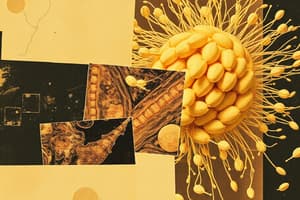Podcast
Questions and Answers
What is the role of the 'Cl' in the nucleophilic substitution reaction?
What is the role of the 'Cl' in the nucleophilic substitution reaction?
- It is a catalyst for the reaction.
- It acts as a nucleophile.
- It promotes the formation of the polymer.
- It is a leaving group that can stabilize negative charge. (correct)
Which of the following is a potential by-product when synthesizing Kevlar?
Which of the following is a potential by-product when synthesizing Kevlar?
- Ethanol
- Ammonia
- Hydrochloric acid (correct)
- Water (correct)
What type of reaction is primarily involved in the synthesis of Kevlar?
What type of reaction is primarily involved in the synthesis of Kevlar?
- Polycondensation reaction (correct)
- Elimination reaction
- Addition reaction
- Redox reaction
Which characteristic of leaving groups makes them effective in nucleophilic substitution reactions?
Which characteristic of leaving groups makes them effective in nucleophilic substitution reactions?
Which of the following polymers is structurally similar to Kevlar?
Which of the following polymers is structurally similar to Kevlar?
What is the primary connection between monomers in polyethylene terephthalate (PET)?
What is the primary connection between monomers in polyethylene terephthalate (PET)?
Which of the following is NOT a method for producing esters?
Which of the following is NOT a method for producing esters?
Which of the following best describes an activated acid in ester synthesis?
Which of the following best describes an activated acid in ester synthesis?
What is a significant environmental concern related to polyethylene terephthalate (PET)?
What is a significant environmental concern related to polyethylene terephthalate (PET)?
In the context of polymer reactions, what is a common by-product formed when creating esters from carboxylic acids and alcohols?
In the context of polymer reactions, what is a common by-product formed when creating esters from carboxylic acids and alcohols?
What is the primary characteristic of a good leaving group in nucleophilic substitution reactions?
What is the primary characteristic of a good leaving group in nucleophilic substitution reactions?
Which of the following polymers is synthesized through a condensation reaction similar to that of PET?
Which of the following polymers is synthesized through a condensation reaction similar to that of PET?
What role does the acid catalyst play in the formation of esters?
What role does the acid catalyst play in the formation of esters?
What is the main characteristic that affects the stability of the leaving group X- in nucleophilic substitution reactions involving carboxylic acid derivatives?
What is the main characteristic that affects the stability of the leaving group X- in nucleophilic substitution reactions involving carboxylic acid derivatives?
Which acid derivative has the lowest pKa, indicating a more favorable leaving group in nucleophilic substitution?
Which acid derivative has the lowest pKa, indicating a more favorable leaving group in nucleophilic substitution?
In the synthesis of nylon 6,10, what is the type of reaction primarily involved?
In the synthesis of nylon 6,10, what is the type of reaction primarily involved?
Which of the following is a characteristic of anhydrides in terms of reactivity in nucleophilic substitution?
Which of the following is a characteristic of anhydrides in terms of reactivity in nucleophilic substitution?
What type of by-products can be expected in polymer reactions such as the synthesis of polyamides?
What type of by-products can be expected in polymer reactions such as the synthesis of polyamides?
What is the expected outcome when a nucleophile attacks an acid chloride?
What is the expected outcome when a nucleophile attacks an acid chloride?
Why are acid derivatives considered to undergo nucleophilic substitution reactions at different rates?
Why are acid derivatives considered to undergo nucleophilic substitution reactions at different rates?
What is an essential factor that differentiates nylon from other types of polymers?
What is an essential factor that differentiates nylon from other types of polymers?
Flashcards are hidden until you start studying
Study Notes
Amide Synthesis
- Amides are formed via nucleophilic substitution at the carbonyl group.
- The reaction involves an acid chloride and ammonia.
- The "Cl" is called a leaving group and can stabilize a negative charge.
- A good leaving group can stabilize a negative charge.
Polymer Synthesis
- Kevlar is a polymer.
- Potential starting materials for Kevlar include a diamine and a diacid chloride.
- Byproducts are formed from the reaction including HCl.
Polyethylene Terephthalate (PET)
- PET is a polymer made up of monomers linked by esters.
- It is widely used for plastic bottles.
- 91% of PET is not recycled and decomposes naturally over 400 years.
Ester Synthesis
- Esters can be made from a carboxylic acid and an alcohol with an acid catalyst.
- Activated acids are often used in ester synthesis.
- Activated acids include acid chlorides and acid anhydrides.
Nylon 6,10 Synthesis
- Nylon 6,10 is a polyamide.
- Its synthesis is fast.
Nucleophilic Substitution at the Carbonyl and Rate
- The rate of nucleophilic substitution at the carbonyl group depends on the stability of the leaving group.
- Stability of the leaving group is determined by its pKa value.
- A more stable leaving group will result in a faster reaction.
- The stability of the leaving group decreases from acid chlorides to carboxylic acid anhydrides to esters to amides.
Summary
- Amides are synthesized via nucleophilic substitution at the carbonyl group.
- The stability of the leaving group influences the rate of nucleophilic substitution at the carbonyl group.
- Polymers like Kevlar and PET are formed from specific monomers.
Studying That Suits You
Use AI to generate personalized quizzes and flashcards to suit your learning preferences.




